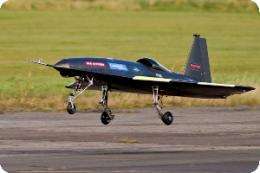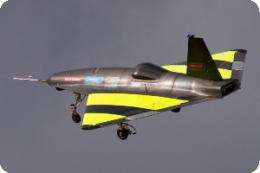Showcase UAV demonstrates 'Flapless Flight'

(PhysOrg.com) -- A novel unmanned air vehicle (UAV) which showcases a wide range of new technologies has successfully demonstrated 'flapless flight' in the UK.
The UAV, called DEMON, made the historic flight from an airfield at Walney Island in Cumbria on Friday 17 September. Developed by Cranfield University, BAE Systems, and nine other UK universities, DEMON is designed to be able to forgo the use of conventional mechanical elevators and ailerons which usually control the movement of an aircraft in favour of novel aerodynamic control devices using blown jets of air.
Such an approach offers several advantages over ‘moving flap’ technology which has been used since the early days of aviation, in that it means fewer moving parts, less maintenance, and a more stealthy profile for the aircraft. DEMON’s trial flights were the first ‘flapless flights’ ever to be authorised by the UK Civil Aviation Authority.
In Cumbria, DEMON successfully demonstrated flapless flight when, for a planned portion of a test-flight, the conventional flap control system was turned off and the aircraft flew and manoeuvred using the new technology. BAE Systems promoted the development of the £6.2m FLAVIIR (Flapless Air Vehicle Integrated Industrial Research) programme which led to the DEMON demonstrator after laying down a ‘Grand Challenge’ to UK universities five years ago.
Professor John Fielding, chief engineer and lead for the DEMON demonstrator team from Cranfield University, said: “To make an aircraft fly and manoeuvre safely without the use of conventional control surfaces is an achievement in itself; to do that while at the same time bringing together new construction techniques and new control mechanisms could be said to be over-ambitious - but we have done it. The DEMON UAV has been developed within a research programme but it is a representative, complex, high technology aircraft. Gaining approval from the CAA and flying it successfully has required great skill, dedication and patience by the team and they should be very proud of their achievement.”
Richard Williams, BAE Systems programme director for Future Capability, said: “What the FLAVIIR Team have achieved in such a short time is nothing short of remarkable. I was in Cumbria to watch DEMON fly and I feel sure I have witnessed a significant moment in aviation history.” He added: “What makes it even more poignant is that this is the result of British brains collaborating to produce world-leading technology. It, and other initiatives like it, will help ensure we maintain both a level of sovereign capability and a competitive edge.”

The flapless system, developed around a concept called fluidic flight control, was the result of collaborative work between Cranfield and Manchester universities together with BAE Systems' Advanced Technology Centre and was tested in wind tunnels and on models before the full-scale trials on DEMON took place.
While Demon itself is not expected to become a production aircraft, a number of the technologies it contains have and will continue to filter through to a range of other aviation platforms.
DEMON Key Facts:
• Weight: 200 lbs (90 kg); Dimensions:approximately 8-foot (2.5m) wingspan Flight speed 70 -150kts.
• It was developed by BAE Systems and Cranfield University in the UK. It incorporates fluidic flight controls developed at Cranfield and Manchester Universities and flight control algorithms developed at Leicester University and Imperial College
• The DEMON is designed to fly with no conventional elevators or ailerons, getting its pitch and roll control from technologies which rely on blown air and so requires much fewer moving parts, therefore making it a lot easier to maintain and repair.
• DEMON can fly parts of its mission by itself but, as it is currently an experimental vehicle, is not fully autonomous unlike, for example, BAE Systems’ MANTIS.
• The shape of the DEMON aircraft is referred to as a "blended wing-body" configuration.
Provided by Cranfield University


















